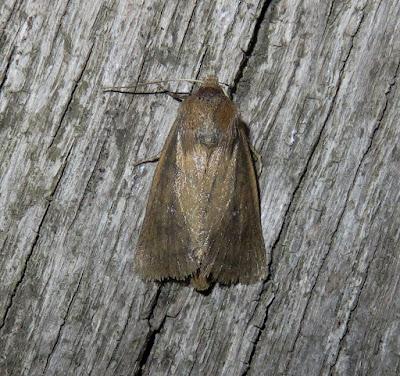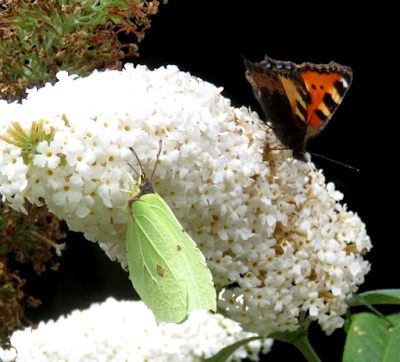Four whinchats were perched on bushes beside the Maydays farm borrow-dyke in the shimmering heat of Monday 29th. There was plenty of sunshine during the walk along the seawall but there was a strong heat haze too. The whinchats are having a brief stop-over here for a day or so before continuing south for the winter.
Birds noted over Reeveshall and Maydays included a common buzzard, 2 kestrels, yellowhammer, 2 reed warblers, lesser whitethroat, 2 common whitethroats, 6 linnets, 20 house martins and a yellow wagtail.
Birds noted over Reeveshall and Maydays included a common buzzard, 2 kestrels, yellowhammer, 2 reed warblers, lesser whitethroat, 2 common whitethroats, 6 linnets, 20 house martins and a yellow wagtail.
As the tide receded during the middle part of the day, this common seal enjoyed a bit of basking on the north side of the Pyefleet. Two more seals were basking on the saltmarsh further up the Pyefleet.
Birds feeding along the channel were 2 little terns, common tern, whimbrel, 8 little egrets, 50 grey plover and 100 redshank. On Langenhoe a hobby appeared to be hawking after dragonflies while a female marsh harrier was seen quartering the marsh.
Several butterflies were noted in the hot conditions with two clouded yellows of most interest, also 10 common blues, 15 small heath, 2 small tortoiseshell and 25 small whites seen.
In Firs Chase a willow warbler in the garden first thing, a yellow wagtail, 10 swallows, 10 house martins and kestrel flew over while 3 common buzzard and a sparrowhawk circled high over the Hard.
A search for curlew sandpipers proved rewarding along the east end of the Pyefleet on Sunday when 11 birds were found on the mud near the Oyster Fishery. The digiscoped image above shows a moulting adult on the left and a juvenile on the right - as were most of the others seen close-by. Later in the afternoon, quite possibly the same eleven birds were seen near Ivy Dock by Steve Entwistle.Birds feeding along the channel were 2 little terns, common tern, whimbrel, 8 little egrets, 50 grey plover and 100 redshank. On Langenhoe a hobby appeared to be hawking after dragonflies while a female marsh harrier was seen quartering the marsh.
Several butterflies were noted in the hot conditions with two clouded yellows of most interest, also 10 common blues, 15 small heath, 2 small tortoiseshell and 25 small whites seen.
In Firs Chase a willow warbler in the garden first thing, a yellow wagtail, 10 swallows, 10 house martins and kestrel flew over while 3 common buzzard and a sparrowhawk circled high over the Hard.
Other birds at that end of the Pyefleet with the tide going out were 50 avocet, 200+ golden plover, 10 ringed plover, 10 dunlin, 8 grey herons, while 50 common terns were feeding on a shoal of fish in the Colne.
On the army ranges of Langenhoe on Sunday, Richard Hull and Andy Field saw the red-backed shrike still present after being first seen on Friday. Also garganey, 2 little stint and 6 curlew sandpipers 6 green sandpipers, 4 ruff, 2 greenshank, common sandpipers, 3 marsh harriers, hobby and juvenile cuckoo while on Friday 6 whinchat were seen.
This family of mute swans with three young have recently taken up residence in this dyke near Shop Lane, probably a family from Reeveshall's Broad Fleet.
Calling from the clubrush filled dyke between Ivy Dock and the Oyster Fishery was a water rail which showed itself as it preened. Twenty swallows passed over as did a couple of sand martins.
A common sandpiper was heard calling in flight as it passed south over the country park just after dark on Saturday night.
Calling from the clubrush filled dyke between Ivy Dock and the Oyster Fishery was a water rail which showed itself as it preened. Twenty swallows passed over as did a couple of sand martins.
A common sandpiper was heard calling in flight as it passed south over the country park just after dark on Saturday night.
A couple of walks were made along the Strood seawall on Saturday at low tide and also the day before at high tide, as seen above. Most birds were noted on Saturday such as a pair of Mediterranean gulls, 4 greenshank, 25 grey plover, 200+ redshank, kestrel and 10 linnets. On Friday 100 golden plover were in the field and 2 common terns were along the Strood.
Two Mediterranean gulls were seen flying off the field at Chapmans Lane on Friday morning.
Two Mediterranean gulls were seen flying off the field at Chapmans Lane on Friday morning.
A pair of common darters were perched on a couple of posts in the Firs Chase garden on Sunday 28th while a couple of migrant hawkers were busy catching insects.
The only butterflies noted in the garden have been speckled wood, several small white, red admiral, comma and holly blue.
The only butterflies noted in the garden have been speckled wood, several small white, red admiral, comma and holly blue.
The moth trap was run at the country park on the nights of the 25th and the 27th, with the latter being better with 240 macro moths of 34 species. This worn bordered beauty was a nice addition to the recent regular fare.
The second Webb's wainscot of the year was probably the most notable although the earlier record was in a different location, by the seawall a fortnight previously.
A shiny burnished brass visited the trap on the 25th, the coppery sheen showing up nicely.
One of the autumnal coloured moths, the frosted orange was seen on the 25th.
Other moths included oak hook-tip, orange swift, Chinese character, green carpet, sharp-angled peacock, latticed heath, poplar hawkmoth, iron prominent, white-point, tree lichen beauty, sandhill rustic as well as a few rusty dot pearls and rush veneers.
Other moths included oak hook-tip, orange swift, Chinese character, green carpet, sharp-angled peacock, latticed heath, poplar hawkmoth, iron prominent, white-point, tree lichen beauty, sandhill rustic as well as a few rusty dot pearls and rush veneers.



















































